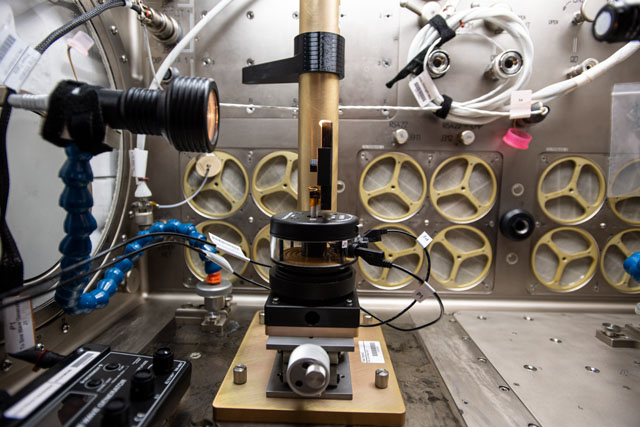Station Science Top News: Dec. 1, 2022
Researchers used water on water-repellant Teflon surfaces aboard the International Space Station (ISS) to validate a widely accepted theory that droplets form a “bridge” between themselves before merging into one. Understanding how droplets merge can improve condensing steam systems for energy generation, thermal management of electronics, and self-cleansing surfaces.
In microgravity, droplets are typically larger and move more slowly, facilitating the analysis of contact lines and the spreading of droplets. For this study, two droplets were placed near each other and influenced to merge into one drop either by increasing water in one drop to expand its size and push it toward the other or by guiding one droplet with a syringe. Results showed agreement between experimentally tested values and computational simulations.

Documentation of Drop Vibration experiment hardware set up inside the Microgravity Science Glovebox aboard the International Space Station. Credits: NASA
***
Ukrainian student experiments launched aboard SpaceX CRS-26 as a part of the Student Spaceflight Experiments Program (SSEP) sponsored by the National Center for Earth and Space Science Education. SSEP gives students ranging from 5th grade to college the chance to send research to space, encouraging students from around the world to explore STEM careers.
In 2019, Dr. Yevhen Kudriavets of the Junior Academy of Sciences of Ukraine visited the United States and brought students to Space Center Houston. Personnel from the ISS Program Office set up meetings with various implementation partners so that the team could learn of the opportunities available for launching experiments to the space station. Their experiments are two of 21 SSEP student experiments selected from 1,262 proposals to fly on SpaceX-26.
The two experiments are:
- Dental Filling Material Solidification in Microgravity Conditions, which tests how microgravity affects dental restorative material adhesion and structure by analyzing differences between filling materials prepared in space and on Earth. This information could help keep crews safe on deep space missions.
- The Effects of Microgravity on Potassium Hexacyanoferrate (III) Crystals studies microgravity’s effect on the shape and volume of these crystals during their growth. Crystal growth is one of the most studied topics aboard the space station, and insight into the process can contribute to industrial production back on Earth.
***
Scientists used optic nerve sheath diameter (ONSD) as an indicator of increased intracranial pressure and a way to identify a condition known as Space-Associated Neuro-Ocular Syndrome, or SANS. A review of 13 studies revealed that there is no consensus for how to reliably measure ONSD. Developing a way to standardize data collection could assist with the study of SANS and help keep crew members healthy on deep space missions.
The Vision Impairment and Intracranial Pressure investigation aboard the space station examined the effect of long-term exposure to microgravity on the structure of the eye. For this review, researchers compared the image acquisition parameters of ultrasound and MRI experimental designs that measured ONSD across different microgravity settings. The current lack of consensus is due to the variability in image acquisition parameters and a publication gap from in-flight space station investigations. To standardize data collection, researchers recommend the use of baselines in both ultrasound and MRI procedures, better documentation, and providing sample images.
Learn more in this infographic.







